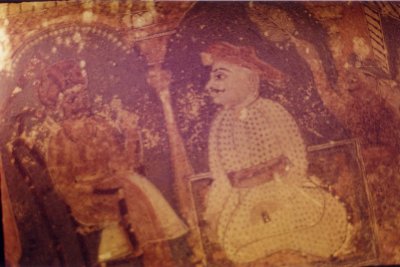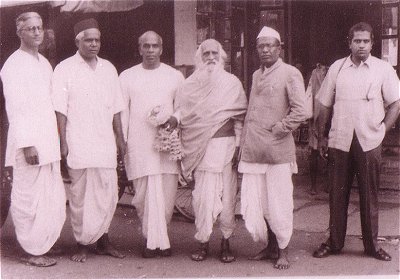A Brief History of Karnataka
by Vikas Kamat
First Online: Golden Jubilee Year of Karnataka (2006)
Page Last Updated: December 07, 2024
Prehistoric and Early History
A number of stone age and Paleolithic artifacts have been found in present-day Karnataka, and we can infer that this area of Deccan Plateau has been habitated by the mankind from pre-historic times.
In the early historical period, Karnataka formed a part of the Mauryan empire under emperor Ashoka, which fact is attested to by the presence of ten Ashokan edicts at places such as Maski, Koppaii, Brahmagiri, Siddapura, Jatingarameshwara, Nittur and Udegolam.
After the Mauryas, this land came under the rule of the Satavahanas (a.k.a. Shatavanahanas), who ruled for about four hundred and fifty years (c. 50 B.C. to 250 A.D.). A large number of archaeological sites, distributed over the whole of Karnataka, have yielded a painted pottery popularly known as russet-coated-pottery and identified with the Satavahana period. This period witnessed nourishing trade contacts with the far-away Roman empire. A number of Roman coins have been found in Karnataka, as well as gold coins of the early Roman emperors and later Byzantine rulers.

A Roman Coin found at Banavasi
The Kadambas succeeded the Satavahanas in this region, who wrested from the Pallavas of Kanchi additional areas, and established the Kadamba kingdom, with its capital at Banavasi in North Kanara district. Their rule extended for two hundred years (4th to 6th Century A.D.). Even after the disintegration of the Kadamba empire, this dynasty survived to govern as the Mahamandaleshwaras, with their capitals at Goa, Hangal and Chandavara. The counterpart of the Kadambas in southern Karnataka were the Gangas, who ruled for nearly seven hundred years, with their capital at Talkad.
Medieval Period
The emergence of the Badami Chalukyas in the region initiated a brilliant epoch in the history of Karnataka. With their capital at Badami, they ruled for a period of nearly three centuries, from the sixth century A.D. onwards. Famous rulers of this dynasty include Pulakeshi-I, who fortified Badami and performed the Ashvamedha sacrifice, Pulakeshi-II, who defeated Harsha Vardhana (the emperor of Kanoj), and finally Vikramaditya-II, who defeated the Pallava king of Kanchi three times. These rulers made outstanding contributions to art and literature of Karnataka. Similarly, the Rashtrakootas of Malkhed, who ruled from about 753 A.D. to 973 A.D. over parts of what is now called Karnataka, contributed significantly to the culture. Dhruva (780-794), Govinda-III (793-814), Amogha Varsha Nripatunga-I (814-878) and Krishna-III (939-966) are the great monarchs of this dynasty. The most noteworthy contribution of this dynasty is the magnificient Kailash temple at Ellora.
The Chalukyas, who were eclipsed during the glorious days of the Rashtrakootas, reemerged under Tallapa for nearly two centuries later, with their capital at Kalyana and are referred to as the Chalukyas of Kalyan. The ablest ruler of this dynasty was Vikramaditya-VI, the celebrated founder of the Chalukya Vikramaditya era, who ruled for fifty years. It is the Chalukyas of Kalyana who started a new trend in the art of temple building, using a softer stone medium, which for the first time borrowed heavily from the intricate and exuberant wood-craft prevalent at the time. This new style was further improved by the Hoysalas in southern Karnataka. The Katahuri kings replaced the Chalukyas and continued to rule with Kalyani as their capital. Billala was the most important king of this line, whose minister was the great socio-religious reformer Basaveshwara .
Contemporaneous to the Kalyani Chalukyas and Kalachuris, in the southern part of Karnataka the Hoysalas held sway with their capital at Dorasamudra (Halebidu). Vishnuvardhana and Ballala-III are two illustrious rulers of this dynasty. The most notable contribution of this dynasty was the construction of a series of more than three hundred highly ornate temples, in the Hoysala style very typical of this time.
The founding of the Vijayanagara empire in the 14th century A.D. marked the culmination of the achievements of the people of south India, besides being a great cultural renaissance. The two centuries, during which this dynasty ruled the whole of South India, witnessed not only a great flowering in all the fields of art and literature but also a stout defense of its cultural heritage against external invaders. The most illustrious name of this dynasty is that of Krishnadevaraya, a Tuluva (Tulu-speaker) from South Kanara, whose reign marked the grand climax in the development of the empire, and the achievement of the objectives for which it was actually founded.
Religious History of Karnataka
The four primary religious faiths of Karnataka have been Shaivism (followers of Shiva), Vaishnavism (followers of Vishnu and his avatars), Buddhism, and Jainism. Prominent saints Shankaracharya, and Ramanujacahrya lived in Karnataka for a long time and established deep roots. Saints Madhwacharya and Basaveshwara were indeed born in Karnataka and have left a lasting impact.
The subsequent practitioners of the Bhakti movement in Karnataka enriched the Kannada language and south Indian music. For a detailed study of Vachana literature and Dasa literature, please see Dr. Jyotsna Kamat's series on History of Kannada Language.
Karnataka During 18th and 19th Centuries
The cultural leadership established by the Vijayanagar kings continued to flourish under the Nayakas of Keladi and the Wodeyars of Mysore in the south, while the area north of the Tungabhadra river came under the sway of the Bahamani kings. Hyder Ali united small principalities under the throne of Mysore. Most of the northern parts later fell into the hands of the Marathas. Western parts were integrated by the British into the Bombay Presidency and but for Mysore, the southern parts came under the Madras Presidency and under the British Raj. The British built military bases (Cantonments) in Bangalore, Belgaum, and Bellary.
K.L. Kamat/Kamat's Potpourri
Hyder Ali and Tippu Sultan
Young Tippu (squatting on the right) consults with his father Hyder Ali.
Detail from a Wall mural in Sibi.
See Also: Tippu Sultan, Mummadi Krishnaraja Wodeyar, Dewan Purnaiah
Unification as a State and Kannada Renaissance
The period between 1905 to 1920 can be described as the period of unification of Karnataka. On one hand, the leaders fought for India's freedom and on the other, they dreamt of a building a united Karnataka state, that had since been broken into twenty different segments [2].
K.L. Kamat/Kamat's Potpourri
Those Who Saved Kannada
(L to R) Nadiger, G.B. Joshi, K.V. Iyer, Alur Venkata Rao, V.B.Naik , Karna
After 1924, when the Congress supported forming of the state of Karnataka, the unification movement got a big boost. However the forming of the state (called Mysore State then) did not materialize till November 1, 1956. Many great men (among them: Alur Venkatarao, Goruru Ramaswamy Iyengar, S. Nijalingappa, and Kengal Hanumantiah) worked relentlessly to coerce, lobby, and win over the fighting factions.
The state was renamed as Karnataka (see about the name) on November 1, 1973.
The new found state inspired great works of literature, poetry, theater, cinema and other arts in the local population. The formation of state of Karnataka is the reason why the 20th century Kannada literature is so rich.
See also:
References
- L. K. Srinivasan, "Cultural Heritage of Karnataka", Dasara Cultural Festivities Souvenir 1983 © Government of Karnataka
- Kamath Suryanath U., "Karnatakada Sanksipta Itihasa", Bapco Publications, Bangalore, 1973
- Gangarams, "Karnataka -- Impressions" , 1989

